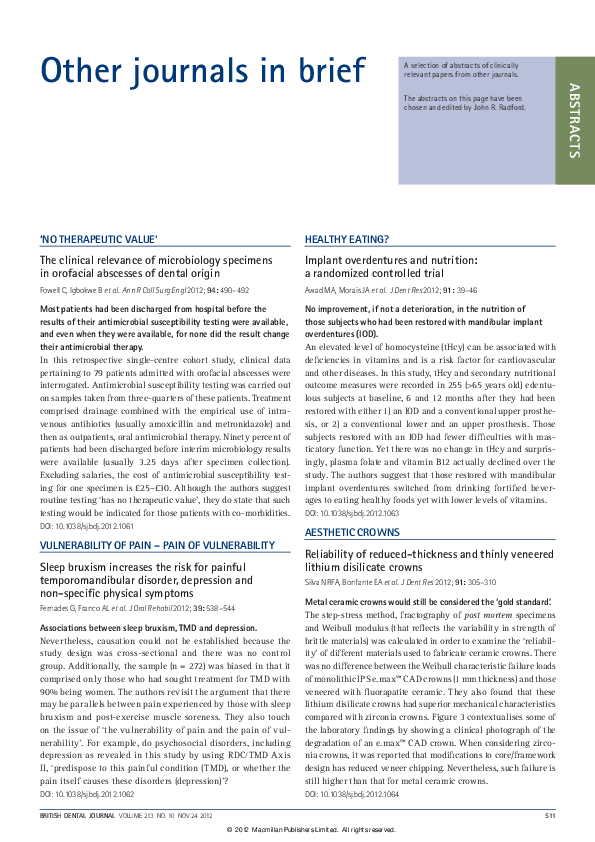Academia.edu no longer supports Internet Explorer.
To browse Academia.edu and the wider internet faster and more securely, please take a few seconds to upgrade your browser.
Sleep bruxism increases the risk for painful temporomandibular disorder, depression and non-specific physical symptoms
Sleep bruxism increases the risk for painful temporomandibular disorder, depression and non-specific physical symptoms
Sleep bruxism increases the risk for painful temporomandibular disorder, depression and non-specific physical symptoms
Sleep bruxism increases the risk for painful temporomandibular disorder, depression and non-specific physical symptoms
Sleep bruxism increases the risk for painful temporomandibular disorder, depression and non-specific physical symptoms
2012, Journal of Oral Rehabilitation
ABSTRACTS
Other journals in brief
A selection of abstracts of clinically
relevant papers from other journals.
The abstracts on this page have been
chosen and edited by John R. Radford.
‘NO THERAPEUTIC VALUE’
HEALTHY EATING?
The clinical relevance of microbiology specimens
in orofacial abscesses of dental origin
Implant overdentures and nutrition:
a randomized controlled trial
Fowell C, Igbokwe B et al. Ann R Coll Surg Engl 2012; 94: 490–492
Awad MA, Morais JA et al. J Dent Res 2012; 91: 39–46
Most patients had been discharged from hospital before the
results of their antimicrobial susceptibility testing were available,
and even when they were available, for none did the result change
their antimicrobial therapy.
In this retrospective single-centre cohort study, clinical data
pertaining to 79 patients admitted with orofacial abscesses were
interrogated. Antimicrobial susceptibility testing was carried out
on samples taken from three-quarters of these patients. Treatment
comprised drainage combined with the empirical use of intravenous antibiotics (usually amoxicillin and metronidazole) and
then as outpatients, oral antimicrobial therapy. Ninety percent of
patients had been discharged before interim microbiology results
were available (usually 3.25 days after specimen collection).
Excluding salaries, the cost of antimicrobial susceptibility testing for one specimen is £25–£30. Although the authors suggest
routine testing ‘has no therapeutic value’, they do state that such
testing would be indicated for those patients with co-morbidities.
No improvement, if not a deterioration, in the nutrition of
those subjects who had been restored with mandibular implant
overdentures (IOD).
An elevated level of homocysteine (tHcy) can be associated with
deficiencies in vitamins and is a risk factor for cardiovascular
and other diseases. In this study, tHcy and secondary nutritional
outcome measures were recorded in 255 (>65 years old) edentulous subjects at baseline, 6 and 12 months after they had been
restored with either 1) an IOD and a conventional upper prosthesis, or 2) a conventional lower and an upper prosthesis. Those
subjects restored with an IOD had fewer difficulties with masticatory function. Yet there was no change in tHcy and surprisingly, plasma folate and vitamin B12 actually declined over the
study. The authors suggest that those restored with mandibular
implant overdentures switched from drinking fortified beverages to eating healthy foods yet with lower levels of vitamins.
DOI: 10.1038/sj.bdj.2012.1061
DOI: 10.1038/sj.bdj.2012.1063
AESTHETIC CROWNS
VULNERABILITY OF PAIN – PAIN OF VULNERABILITY
Sleep bruxism increases the risk for painful
temporomandibular disorder, depression and
non-specific physical symptoms
Reliability of reduced-thickness and thinly veneered
lithium disilicate crowns
Silva NRFA, Bonfante EA et al. J Dent Res 2012; 91: 305–310
Associations between sleep bruxism, TMD and depression.
Nevertheless, causation could not be established because the
study design was cross-sectional and there was no control
group. Additionally, the sample (n = 272) was biased in that it
comprised only those who had sought treatment for TMD with
90% being women. The authors revisit the argument that there
may be parallels between pain experienced by those with sleep
bruxism and post-exercise muscle soreness. They also touch
on the issue of ‘the vulnerability of pain and the pain of vulnerability’. For example, do psychosocial disorders, including
depression as revealed in this study by using RDC⁄TMD Axis
II, ‘predispose to this painful condition (TMD), or whether the
pain itself causes these disorders (depression)’?
Metal ceramic crowns would still be considered the ‘gold standard’.
The step-stress method, fractography of post mortem specimens
and Weibull modulus (that reflects the variability in strength of
brittle materials) was calculated in order to examine the ‘reliability’ of different materials used to fabricate ceramic crowns. There
was no difference between the Weibull characteristic failure loads
of monolithic IPS e.max™ CAD crowns (1 mm thickness) and those
veneered with fluorapatite ceramic. They also found that these
lithium disilicate crowns had superior mechanical characteristics
compared with zirconia crowns. Figure 3 contextualises some of
the laboratory findings by showing a clinical photograph of the
degradation of an e.max™ CAD crown. When considering zirconia crowns, it was reported that modifications to core/framework
design has reduced veneer chipping. Nevertheless, such failure is
still higher than that for metal ceramic crowns.
DOI: 10.1038/sj.bdj.2012.1062
DOI: 10.1038/sj.bdj.2012.1064
Fernades G, Franco AL et al. J Oral Rehabil 2012; 39: 538–544
BRITISH DENTAL JOURNAL VOLUME 213 NO. 10 NOV 24 2012
511
© 20 12 M acmillan Publishers Limited. All rights reserved.
- Find new research papers in:
- Physics
- Chemistry
- Biology
- Health Sciences
- Ecology
- Earth Sciences
- Cognitive Science
- Mathematics
- Computer Science

 Cinara Maria Camparis
Cinara Maria Camparis